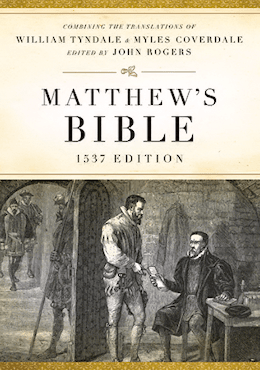Textus Receptus Bibles
Matthew's Bible 1537
| 2:1 | Wherfor we ought to geue the more heede to the thynges which we haue heard, lest we perishe. |
| 2:2 | For yf the word which was spoken by Angels was stedfast, so that euery transgression and disobedience receyued a iuste recompence to rewarde, |
| 2:3 | howe shal we escape, yf we despise so great saluacyon, whyche at the fyrst began to be preached of the Lorde hym selfe, and afterward was confirmed to vswarde, by them that hearde it, |
| 2:4 | God bearynge wytnesse therto, both wyth signes and wonders also, and with diuers miracles, and giftes of the holy ghoste, according to his own will. |
| 2:5 | He hath not vnto the Angelles put in subieccion the world to come, wherof we speake. |
| 2:6 | But one in a certaine place wytnessed, saying. What is man, that thou arte mindfull of him? |
| 2:7 | After thou haddeste for a season made him lower then the Angelles: thou crownedst him with honoure and glorye, and hast set him aboue the workes of thy handes. |
| 2:8 | Thou hast put all thinges in subieccion vnder hys fete. In that he put al thinges vnder hym, he lefte nothinge that is not put vnder him. |
| 2:9 | Neuertheles we yet se not all thinges subdued, but him that was made lesse then the Angelles, we se that it was Iesus, whiche is crowned with glory and honoure for the suffering of death, that he by the grace of God, should taste of death for al men. |
| 2:10 | For it became him, for whom are al thynges and by whom are al thinges, after that he had brought many sonnes vnto glory, that he should make the Lorde of their saluacyon perfect thorowe sufferinge. |
| 2:11 | For he that sanctifieth, and they which are sanctified, are all of one: For whiche causes sake, he is not ashamed to cal them brethren |
| 2:12 | sayinge: I wyll declare thy name vnto my brethren and in the middes of the congregacion wil I praise the. |
| 2:13 | And again: I wil put my truste in him. And agayne: beholde here am I and the chyldren, which God hath geuen me. |
| 2:14 | For as muche then as the children were partetakers of fleshe and bloude, he also him selfe lyke wyse toke part wyth them, for to put doune thorowe death, that is to saye the deuyll, |
| 2:15 | and that he mighte delyuer them, which thorowe feare of death weare all theyr lyfe tyme in daunger of boundage. |
| 2:16 | For he in no place taketh on him the angels, but the seade of Abraham taketh he on hym. |
| 2:17 | Wherfore in al thinges it became him to be made like vnto his brethren, that he myghte be mercyfull and a faythful hye prieste in thinges concerninge God, for to pourge the people synnes. |
| 2:18 | For in that he hym selfe suffered and was tempted, he is able to sucker them that are tempted. |

Matthew's Bible 1537
The Matthew Bible, also known as Matthew's Version, was first published in 1537 by John Rogers, under the pseudonym "Thomas Matthew". It combined the New Testament of William Tyndale, and as much of the Old Testament as he had been able to translate before being captured and put to death, with the translations of Myles Coverdale as to the balance of the Old Testament and the Apocrypha, except the Apocryphal Prayer of Manasses. It is thus a vital link in the main sequence of English Bible translations.